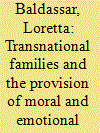| Srl | Item |
| 1 |
ID:
120704


|
|
|
|
|
| Publication |
2013.
|
| Summary/Abstract |
This paper deals with the changing idea of money and the transnational Indian family across generations and life stages. It draws on a qualitative study of 38 first and second generation Indian migrants to Australia. For first generation migrants, sending money home is one of the important ways of expressing belonging and care for the transnational family. Over time, the remittances become contested in terms of their value and their equivalence to physical care, raising questions of belonging. With multiple migrants, the family centres on Australia, which now becomes the source country when children migrate elsewhere. Money and gifts are sent home to Australia or to other countries. The nuclear family is the main reference point for most of our second generation migrants, but there remain some gift exchanges with extended family and charitable donations. These donations reflect a sense of ancestry rather than the locus of family. Hence accounts of sending money to India need to be supplemented by studies of the diffusion of the transnational family across different nodes of the diaspora. The study of remittances has to reflect this diffusion and change in the transnational family if it is to adequately explain how money is the medium of family relationships.
|
|
|
|
|
|
|
|
|
|
|
|
|
|
|
|
| 2 |
ID:
151731


|
|
|
|
|
| Summary/Abstract |
This article examines transnational family development by drawing on the findings of longitudinal research on bi-national marriages between Japanese women and Pakistani men. This type of marriage increased in Japan during the 1990s after a surge in male labor migrants from Pakistan. Very little attention has been given to bi-national relationships between women of the global North and men from the global South. This article explores the ways in which gender, nationality, and other factors intersect in the creation of transnational families. More specifically, it focuses on transnationally split family dynamics in which Japanese wives relocate to Pakistan with their children while their Pakistani husbands remain in Japan to work. These transnational strategies bring the families various opportunities in terms of economic advancement, children’s education, and the provision of care for the elderly. However, they also encounter various challenges as their life-courses unfold. Thus, this article highlights both the possibilities and limitations of these transnational families and shows how these Japanese women contest and negotiate their roles and positions within transnational households.
|
|
|
|
|
|
|
|
|
|
|
|
|
|
|
|
| 3 |
ID:
079651


|
|
|
|
|
| Publication |
2007.
|
| Summary/Abstract |
This article is an ethnographic analysis of transnational family links between adult migrant children living in Australia and their kin in Italy, from the 1950s to the present. A key focus of the article is the persistence of bonds of emotion across distance. Drawing on Finch and Mason's research on caregiving relationships and Hochschild's work on emotional labour, it explores both the positive experiences as well as the tensions associated with the transnational exchange of moral and emotional support. The findings confirm the perseverance of bonds of emotion across distance and thus challenge arguments about the declining bonds within translocal families as a result of globalising processes. The role that new communication technologies play in sustaining these bonds is offered as a possible explanation to account for the apparent increase in the frequency of transnational emotional interaction over time. The article also calls for further work on the influence of physical co-presence or absence on emotional interaction over distance
|
|
|
|
|
|
|
|
|
|
|
|
|
|
|
|